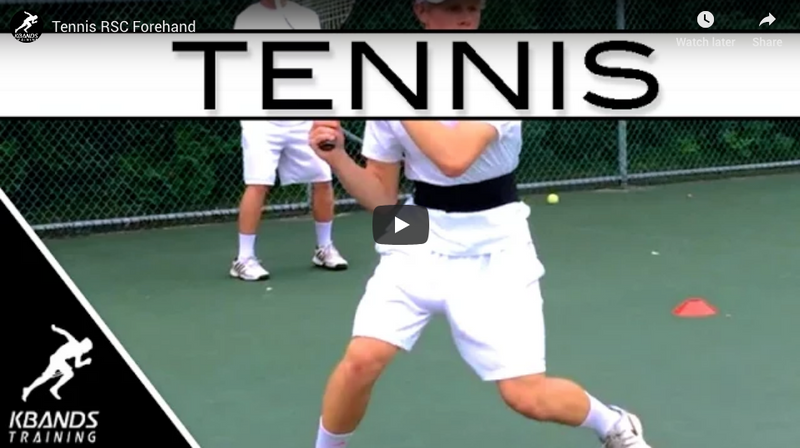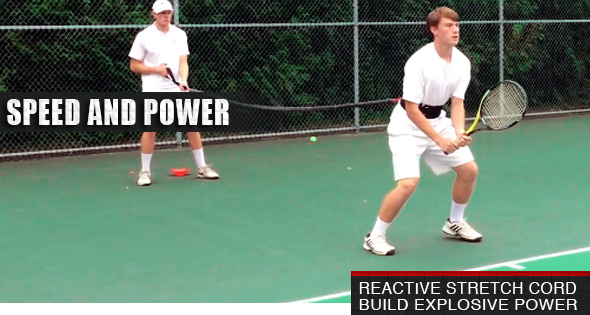Tennis Drills To Improve Tennis Skills | RSC Tennis Forehand Drill
Lateral speed and quickness are key to being successful in tennis. Whether running sideways to volley an opponents shot, or quickly moving the body into position for a tennis forehand, tennis players need to be able to quickly move from side to side on the tennis court. Tennis drills should target and enhance specific tennis skills like lateral quickness and the ability to perform tennis forehands and backhands while quickly moving laterally.
The Reactive Stretch Cord is a great piece of fitness equipment that can be used to apply resistance to athletes moving in any direction. Athletes can go to the Training Section to see similar tennis drills performed with the Kbands Leg Resistance Bands. The Kbands Leg Resistance Bands are a great training compliment to the Reactive Stretch Cord because they provide resistance to the legs helping to quickly build strength in the quads and hip flexors. A wide variety of tennis drills should always be implemented into a training regiment. A wide variety of drills will enhance an athletes’ skill and help take their performance to the next level.
Set Up For The RSC Tennis Forehand Drill
The RSC Tennis Forehand Drill requires one Reactive Stretch Cord, a Speed and Agility Cone, a tennis racket, and two assisting coaches or partners. One partner will hit tennis balls to the athlete while the other partner will anchor the Reactive Stretch Cord. If athletes have a machine to serve the balls then only one partner will be required to anchor the Reactive Stretch Cord during the Tennis Forehand Drill. Athletes will attach the Adjustable Belt to their waist so the 360 D Ring is positioned in the rear of the Adjustable Belt. Anchoring partners will stand 12-20 feet behind the athlete and secure their hand in the Anchor Strap. Athletes will place the Speed and Agility Cone on the midline of the baseline.
Athletes will start the RSC Tennis Forehand Drill at the Speed and Agility Cone and begin the drill when a tennis ball is serviced to them across the net. The speed of the tennis ball coming at the athlete depends on the level of the athletes’ tennis skills. Speeds of all tennis drills should be adapted so the athlete can successfully complete the tennis shot. Tennis players will laterally shuffle, set their bodies, and perform a forehand shot. As athletes take this shot they need to use good body positioning by quickly moving in front of the tennis ball, rotating their hips so they are facing down the baseline, and swing the tennis racket with the chest and shoulders open, finish with a great follow through to fully engage the biceps in the shot.
Coaches or partners serving the tennis balls to the athlete during the RSC Tennis Forehand Drill should challenge the range of the athlete by hitting the balls just at the edge of their range. After an athlete returns a tennis forehand shot they will quickly shuffle back to the Speed and Agility Cone at the center of the baseline. Coaches serving the tennis balls should also try to challenge the pace of the tennis skills drill by immediately serving another tennis ball once the athlete reaches the Speed and Agility Cone.
Tennis players should perform 10-12 tennis forehand hits before rotating with the anchoring partner or resting for 60 seconds. Athletes should perform 2-3 rounds of the RSC Tennis Forehand Drill before moving into more tennis skills training.
Role Of Coaches And Partners In Tennis Drills
Whenever athletes are performing tennis drills with other teammates or coaches it is important all members of the training group take their responsibilities seriously and work to challenge, at a reasonable tempo and resistance, their training partners.
In the RSC Tennis Forehand Drill partners who are anchoring the Reactive Stretch Cord need to remain anchored 12-20 feet behind the Speed and Agility Cone. The maximum distance the Reactive Stretch Cord can stretch is 20 feet and therefore going beyond that distance is not safe for the athlete anchoring the tennis skills drill or the athlete performing the RSC Tennis Forehand Drill. The minimum distance the Reactive Stretch Cord stretches is 12 feet. Therefore partners who position themselves closer than 12 feet will not be putting tension in the Reactive Stretch Cord, which means no resistance is being placed on the athlete during the RSC Tennis Forehand Drill.
Partners or coaches serving the tennis balls to the athlete also need to challenge the athletes by delivering a wide variety of tennis balls in different locations on the tennis court. Increasing the pace of the tennis drills will also help athletes increase their lateral quickness and speed.
Body Positioning During Tennis Drills
When athletes are shuffling laterally it is important they use good body positioning to maximize the speed and distance covered with each movement. As athletes shuffle to the tennis ball they need to focus on keeping their toes pointed forward, maintaining a slight forward lean with the chest, and maintaining a slight bend at the knees and hips while working off the balls of their feet.
As athletes move to their dominant side and prepare to execute the tennis forehand shot they will find it much easier to position their body with the tennis ball. Athletes must move much quicker to position themselves to hit the tennis ball when moving to their non-dominate side. When performing tennis drills involving tennis forehands, athletes need to rotate their hips down the baseline so a full rotation of the hips can be achieved. Athletes who keep their hips square to the net will not be able to generate any rotational power by the lower body. With the stronger muscles of the body located in the lower body it is vital that athletes learn how to properly position their bodies to take advantage of the power in the hips, thighs, and core.


